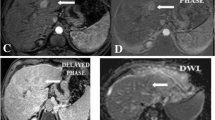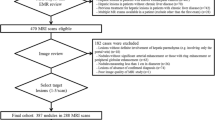Abstract
Purpose
To evaluate value of gadoxetic acid-enhanced and diffusion-weighted (DW) MRI for distinguishing malignant from benign hyperintense nodules on unenhanced T1-weighted images (T1WIs) in patients with chronic liver disease.
Materials and methods
Forty-two patients with 37 malignant and 41 benign hyperintense nodules on unenhanced T1WIs who underwent gadoxetic acid-enhanced and DW MRI, followed by histopathological examination, were included. Qualitative and quantitative analyses were conducted. Significant findings on univariate and multivariate analyses were identified and their diagnostic performances were analyzed for predicting hyperintense hepatocellular carcinomas (HCCs).
Results
In univariate analysis, hyperintensity on T2WI, arterial enhancement, washout, hypointensity on hepatobiliary phase, and diffusion restriction were more frequently observed (P < 0.05) in hyperintense HCCs. Tumor-to-liver SI ratio on hepatobiliary phase and minimum apparent diffusion coefficient (ADCmin) were significantly lower in hyperintense HCCs (P < 0.05). In multivariate analysis, hyperintensity on T2WI (OR, 13.58; P = 0.02), arterial enhancement (OR, 8.21; P = 0.002), and ADCmin ≤ 0.83 × 10−3 mm2/s (OR, 6.88; P = 0.008) were independently significant factors for predicting hyperintense HCCs. When two of three criteria were combined, 75.7% (28/37) of hyperintense HCCs were identified with a specificity of 92.7%, and when all three criteria were satisfied, the specificity was 97.6%.
Conclusion
Gadoxetic acid-enhanced and DW MRI may be helpful for differentiating malignant from benign hyperintense nodules on unenhanced T1WI.




Similar content being viewed by others
Abbreviations
- DW:
-
Diffusion weighted
- T1WI:
-
T1-weighted image
- T2WI:
-
T2-weighted image
- SI:
-
Signal intensity
- CEI:
-
Contrast enhancement index
- ADC:
-
Apparent diffusion coefficient
- OR:
-
Odds ratio
- MR:
-
Magnetic resonance
- HCC:
-
Hepatocellular carcinoma
- AFP:
-
Alpha-fetoprotein
- ROI:
-
Region of interest
- ROC:
-
Receiver operating characteristic
- PPV:
-
Positive predictive value
- NPV:
-
Negative predictive value
References
Matsui O, Kadoya M, Kameyama T, Yoshikawa J, Arai K, Gabata T, et al. Adenomatous hyperplastic nodules in the cirrhotic liver: differentiation from hepatocellular carcinoma with MR imaging. Radiology. 1989;173:123–6.
Choi BI, Takayasu K, Han MC. Small hepatocellular carcinomas and associated nodular lesions of the liver: pathology, pathogenesis, and imaging findings. Am J Roentgenol. 1993;160:1177–87.
Dodd GD, Baron RL, Oliver JH, Federle MP. Spectrum of imaging findings of the liver in end-stage cirrhosis: part II, focal abnormalities. Am J Roentgenol. 1999;173:1185–92.
Ebara M, Fukuda H, Kojima Y, Morimoto N, Yoshikawa M, Sugiura N, et al. Small hepatocellular carcinoma: relationship of signal intensity to histopathologic findings and metal content of the tumor and surrounding hepatic parenchyma. Radiology. 1999;210:81–8.
Shimizu A, Ito K, Sasaki K, Hayashida M, Tanabe M, Shimizu K, et al. Small hyperintense hepatic lesions on T1-weighted images in patients with cirrhosis: evaluation with serial MRI and imaging features for clinical benignity. Magn Reson Imaging. 2007;25:1430–6.
Yu JS, Lee JH, Park MS, Kim KW. Hyperintense nodules on non-enhanced T1-weighted gradient-echo magnetic resonance imaging of cirrhotic liver: fate and clinical implications. J Magn Reson Imaging. 2006;24:630–6.
Yu JS, Kim YH, Rofsky NM. Dynamic subtraction magnetic resonance imaging of cirrhotic liver: assessment of high signal intensity lesions on nonenhanced T1-weighted images. J Comput Assist Tomogr. 2005;29:51–8.
Nasu K, Kuroki Y, Tsukamoto T, Nakajima H, Mori K, Minami M. Diffusion-weighted imaging of surgically resected hepatocellular carcinoma: imaging characteristics and relationship among signal intensity, apparent diffusion coefficient, and histopathologic grade. AJR Am J Roentgenol. 2009;193:438–44.
Parikh T, Drew SJ, Lee VS, Wong S, Hecht EM, Babb JS, et al. Focal liver lesion detection and characterization with diffusion-weighted MR imaging: comparison with standard breath-hold T2-weighted imaging. Radiology. 2008;246:812–22.
Nakanishi M, Chuma M, Hige S, Omatsu T, Yokoo H, Nakanishi K, et al. Relationship between diffusion-weighted magnetic resonance imaging and histological tumor grading of hepatocellular carcinoma. Ann Surg Oncol. 2012;19:1302–9.
International Working Party. Terminology of nodular hepatocellular lesions. Hepatology. 1995;22:983–93
Kojiro M, Wanless IR, Alves V, et al. Pathologic diagnosis of early hepatocellular carcinoma: a report of the international consensus group for hepatocellular neoplasia. Hepatology. 2009;49:658–64
Song KD, Kim SH, Lee J, Kang KA, Kim J, Yoo H. Half-dose gadoxetic acid-enhanced liver magnetic resonance imaging in patients at risk for nephrogenic systemic fibrosis. Eur J Radiol. 2015;84:378–83.
Ebara M, Watanabe S, Kita K, Yoshikawa M, Sugiura N, Ohto M, et al. MR imaging of small hepatocellular carcinoma: effect of intratumoral copper content on signal intensity. Radiology. 1991;180:617–21.
Shinmura R, Matsui O, Kobayashi S, Terayama N, Sanada J, Ueda K, et al. Cirrhotic nodules: association between MR imaging signal intensity and intranodular blood supply. Radiology. 2005;237:512–9.
Chou CT, Chen YL, Wu HK, Chen RC. Characterization of hyperintense nodules on precontrast T1-weighted MRI: utility of gadoxetic acid-enhanced hepatocyte-phase imaging. J Magn Reson Imaging. 2011;33:625–32.
Li CS, Chen RC, Lii JM, Chen WT, Shih LS, Zhang TA, et al. Magnetic resonance imaging appearance of well-differentiated hepatocellular carcinoma. J Comput Assist Tomogr. 2006;30:597–603.
Curvo-Semedo L, Brito JB, Seco MF, Costa JF, Marques CB, Caseiro-Alves F. The hypointense liver lesion on T2-weighted MR images and what it means. Radiographics. 2010;30:e38.
Krinsky GA, Theise ND, Rofsky NM, Mizrachi H, Tepperman LW, Weinreb JC. Dysplastic nodules in cirrhotic liver: arterial phase enhancement at CT and MR imaging—a case report. Radiology. 1998;209:461–4.
Lim JH, Cho JM, Kim EY, Park CK. Dysplastic nodules in liver cirrhosis: evaluation of hemodynamics with CT during arterial portography and CT hepatic arteriography. Radiology. 2000;214:869–74.
Yu JS, Rofsky NM. Dynamic subtraction MR imaging of the liver: advantages and pitfalls. Am J Roentgenol. 2003;180:1351–7.
Mannelli L, Kim S, Hajdu CH, Babb JS, Clark TWI, Taouli B. Assessment of tumor necrosis of hepatocellular carcinoma after chemoembolization: diffusion-weighted and contrast-enhanced MRI with histopathologic correlation of the explanted liver. Am J Roentgenol. 2009;193:1044–52.
Nishie A, Tajima T, Asayama Y, Ishigami K, Kakihara D, Nakayama T, et al. Diagnostic performance of apparent diffusion coefficient for predicting histological grade of hepatocellular carcinoma. Eur J Radiol. 2011;80:e29–33.
Bruegel M, Holzapfel K, Gaa J, Woertler K, Waldt S, Kiefer B, et al. Characterization of focal liver lesions by ADC measurements using a respiratory triggered diffusion-weighted single-shot echo-planar MR imaging technique. Eur Radiol. 2008;18:477–85.
Padhani AR, Liu G, Mu-Koh D, Chenevert TL, Thoeny HC, Takahara T, et al. Diffusion-weighted magnetic resonance imaging as a cancer biomarker: consensus and recommendations. Neoplasia (New York). 2009;11:102–25.
Hardie AD, Kizziah MK, Boulter DJ. Diagnostic accuracy of diffusion-weighted MRI for identifying hepatocellular carcinoma with liver explant correlation. J Med Imaging Radiat Oncol. 2011;55:362–7.
Lee MH, Kim SH, Park MJ, Park CK, Rhim H. Gadoxetic acid-enhanced hepatobiliary phase MRI and high-b-value diffusion-weighted imaging to distinguish well-differentiated hepatocellular carcinomas from benign nodules in patients with chronic liver disease. AJR Am J Roentgenol. 2011;197:W868–75.
Muhi A, Ichikawa T, Motosugi U, Sano K, Matsuda M, Kitamura T, et al. High-b-value diffusion-weighted MR imaging of hepatocellular lesions: estimation of grade of malignancy of hepatocellular carcinoma. J Magn Reson Imaging. 2009;30:1005–11.
Ahn SS, Kim MJ, Lim JS, Hong HS, Chung YE, Choi JY. Added value of gadoxetic acid-enhanced hepatobiliary phase MR imaging in the diagnosis of hepatocellular carcinoma. Radiology. 2010;255:459–66.
Yu MH, Kim JH, Yoon JH, Kim HC, Chung JW, Han JK, et al. Small (≤ 1 cm) hepatocellular carcinoma: diagnostic performance and imaging features at gadoxetic acid-enhanced MR imaging. Radiology. 2014;271:748–60.
Golfieri R, Renzulli M, Lucidi V, Corcioni B, Trevisani F, Bolondi L. Contribution of the hepatobiliary phase of Gd-EOB-DTPA-enhanced MRI to Dynamic MRI in the detection of hypovascular small (≤ 2 cm) HCC in cirrhosis. Eur Radiol. 2011;21:1233–42.
Kogita S, Imai Y, Okada M, Kim T, Onishi H, Takamura M, et al. Gd-EOB-DTPA-enhanced magnetic resonance images of hepatocellular carcinoma: correlation with histological grading and portal blood flow. Eur Radiol. 2010;20:2405–13.
Goncalves Neto JA, Altun E, Elazzazi M, Vaidean GD, Chaney M, Semelka RC. Enhancement of abdominal organs on hepatic arterial phase: quantitative comparison between 1.5- and 3.0-T magnetic resonance imaging. Magn Reson Imaging. 2010;28:47–55.
Funding
This research received no specific grant from any funding agency in the public, commercial, or not-for-profit sectors.
Author information
Authors and Affiliations
Corresponding author
Ethics declarations
Conflict of interest
The authors declare that there is no conflict of interest.
Ethical approval
All applicable institutional and/or national guidelines for the care and use of animals were followed.
About this article
Cite this article
Moon, J.Y., Kim, S.H., Choi, SY. et al. Differentiating malignant from benign hyperintense nodules on unenhanced T1-weighted images in patients with chronic liver disease: using gadoxetic acid-enhanced and diffusion-weighted MR imaging. Jpn J Radiol 36, 489–499 (2018). https://doi.org/10.1007/s11604-018-0748-x
Received:
Accepted:
Published:
Issue Date:
DOI: https://doi.org/10.1007/s11604-018-0748-x




